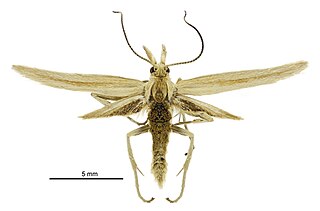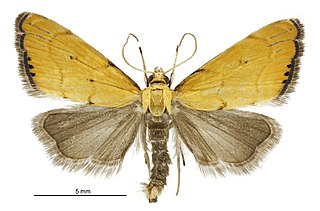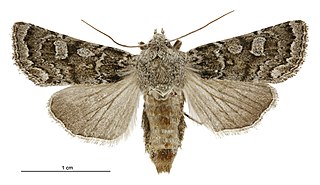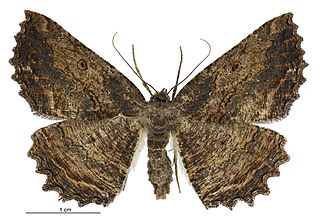
Heloxycanus patricki, also known as the sphagnum porina moth, is a species of moth of the family Hepialidae, the ghost moths. It is the only member of the genus Heloxycanus. This species is endemic to New Zealand. It has been classified as having the status of "At Risk, Declining" by the Department of Conservation.

Proteuxoa sanguinipuncta is a moth of the family Noctuidae. It is found in Queensland, New South Wales, Victoria, Tasmania, South Australia, and south Western Australia. It is also present in New Zealand where it was first recorded in 2007.

Uresiphita ornithopteralis, the tree lucerne moth, is a moth of the family Crambidae. It was described by Achille Guenée in 1854. It is found in New South Wales, Norfolk Island, Queensland, Victoria, South Australia, Tasmania and Western Australia. It is also found in New Zealand.

Exsilirarcha is a genus of moths of the family Crambidae. It contains only one species, Exsilirarcha graminea, which is endemic to New Zealand. Both the genus and the species were described by John Salmon and J. D. Bradley in 1956.

Physetica is a genus of moths of the family Noctuidae. This genus is endemic to New Zealand.

Dasyuris is a genus of moths in the family Geometridae first described by Achille Guenée in 1868.

Helastia is a genus of moths in the family Geometridae erected by Achille Guenée. It is considered by some to be a synonym of Larentia. This genus was redefined and described in 1987 by Robin C. Craw. This genus is endemic to New Zealand.

Paranotoreas is a genus of moths in the family Geometridae. It was described by Robin C. Craw in 1986.

Parienia is a genus of moths belonging to the subfamily Olethreutinae of the family Tortricidae. This genus was described by Edward Meyrick in 1881. It consists of only one species, Parienia mochlophorana, which is endemic to New Zealand.
Inglisella marwicki is a species of sea snail in the family Cancellariidae, the nutmeg snails. It is found in the Exclusive economic zone of New Zealand.

Orthoclydon praefectata, the flax looper moth or flax window maker, is a moth of the family Geometridae. It is endemic to New Zealand.

Stathmopoda horticola, the orchard featherfoot, is a species of moth in the Stathmopodidae family. It was described by John S. Dugdale in 1988. It is endemic to New Zealand.

Glaucocharis holanthes is a moth in the family Crambidae. It was described by Edward Meyrick in 1885. It is endemic to New Zealand.

Glaucocharis leucoxantha is a moth in the family Crambidae. It was described by Edward Meyrick in 1882. It is endemic to New Zealand.

Mnesictena antipodea is a moth in the family Crambidae. It was described by John T. Salmon in 1956. This species is endemic to New Zealand, where it has been recorded from the Antipodes Islands.

Agrotis admirationis is a moth of the family Noctuidae. It is endemic to New Zealand. It was first described by Achille Guenée in 1868 from specimens collected by Richard William Fereday. Specimens of this species have been taken in Christchurch. Its favoured host plants are herbs found in open areas.

Meterana ochthistis is a species of moth in the family Noctuidae. It was described by Edward Meyrick in 1887 from specimens obtained in Christchurch. It is endemic to New Zealand.

Ichneutica sistens is a moth of the family Noctuidae. This species is endemic to New Zealand. It can be found in the central North Island and throughout the South Island, although it is more common on the eastern side of that latter Island. It is very variable in both colour and size. I. sistens prefers open habitat such as tussock grasslands, dunes and braided rivers. Larval host species include grasses in the family Poaceae and include species in the genera Rytidosperma and Elymus, as well as Poa cita and Agrostis capillaris. Adults are on the wing from January to May and are attracted to light.

Gellonia pannularia, the lesser brown evening moth, is a species of moth in the family Geometridae. The species was first described by Achille Guenée in 1868. It is endemic to New Zealand.

Helastia corcularia is a moth of the family Geometridae. This species is endemic to New Zealand and is found only in the South Island and the Chatham Islands. It inhabits a wide variety of habitats including native forest and scrubland, gardens, parks, subalpine and coastal areas. Larvae feed on herbs, lichen and moss. The adults of the species are on the wing from September until May and are nocturnal and attracted to light. H. corcularia is considered an orchard and pack house contaminant.




















